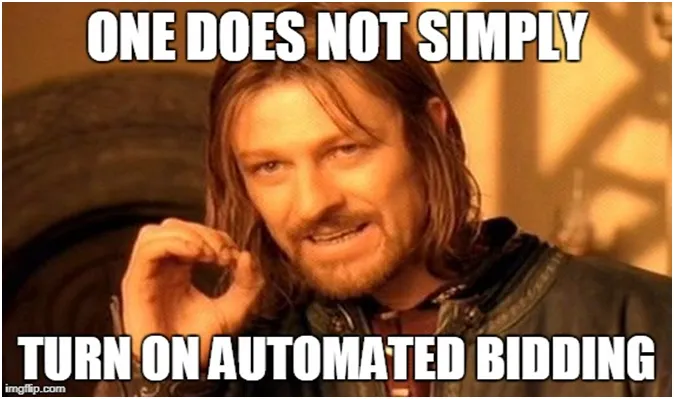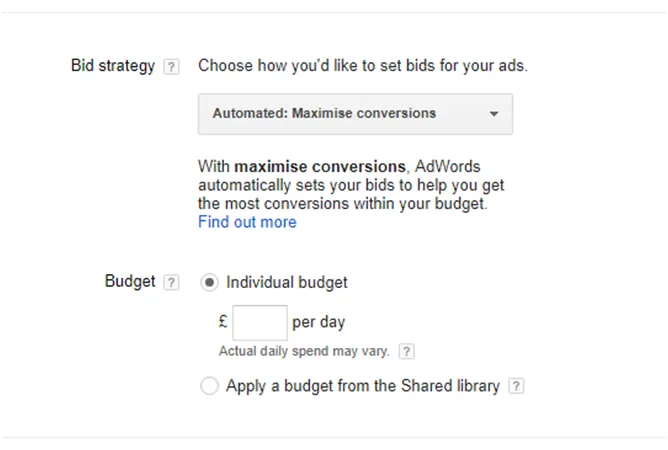People talk about automation in PPC like it’s the coming Rapture. One day, we’ll all ascend to automated heaven and live among the digital clouds. But automation is already here! We’re living with it now in the form of Flexible Bidding Strategies.
Flexible Bidding Strategies
- Target CPA
- Target ROAS
- Maximise for clicks
- Maximise for conversions
- Target Search Page Position
- Target Outranking Share
- ECPC
Flexible (automatic) Bidding Strategies allow you to assign Google a Goal from which it will automatically optimise bids on your keywords.
These strategies use Google’s machine learning to optimise your account in a way the human eye simply couldn’t, whilst saving you swathes of time along the way. The available goals range from maximising clicks on your ads to targeting a certain position on the SERPs (search engine results pages).
In this guide we will cover the best use cases for each bidding strategy along with their various pros and cons.
Don’t get ahead of yourself
Firstly, before you have delusions of turning these strategies on and leaving Google to do all the heavy lifting, forget about it. Whilst these strategies have their place it’s important to still perform basic account maintenance and not completely let go of the wheel. Without regular maintenance and attention, Google can and will take the liberty of going shopping with your credit card…
This includes checking your ads, monitoring competitions, analysing cost per click (CPC) and combing through your search term reports. Make sure your keyword ad groups are up to date and properly organised, because Google doesn’t do everything.

So let’s break down the most common and most effective Flexible Bidding Strategies.
Target Cost Per Acquisition (CPA)
A personal favourite of ours is Target CPA bidding. As the name suggests, it is designed to help you return conversions at a set cost. For example, if you want to spend £30 to acquire each conversion you would simply turn on Target CPA bidding and set the target to £30. This can be extremely effective for advertisers looking to preserve their profit margin.
In accounts where enough data is available, Target CPA bidding can have great results in reducing your cost per acquisition. It uses machine learning in conjunction with the target you have set to optimise your bids to ensure you are returning leads at a rate that is profitable for your business.
Another positive of this bidding method is that it is focused on account profit and loss as opposed to volume of clicks or conversions. By using CPA as your KPI (Key Performance Indicator) you can make sure your account is truly returning value in the long run.
Before enabling Target CPA, Google requires you to have conversion tracking implemented and recommends you to have received at least 15 conversions in the last 30 days. Without at least this amount of data Google cannot optimise the strategy effectively.
Target CPA bidding can be enabled at campaign level or as a shared library bidding strategy. We have found enabling it at campaign level tends to be most effective as various campaigns can have wildly different CPAs.
When setting your target CPA it’s important to be realistic, as setting it too low will just make the account extremely conservative in its bids resulting in no clicks coming through. Typically, we suggest starting with Google’s suggested CPA (this is shown as you setup Target CPA bidding) then scaling down from there. On the flipside, if you set target CPA to high your account simply won’t be profitable.
If you implement target CPA bidding through a shared bidding strategy, you will also have the option to set a global bid cap. Although this sounds attractive we have found this usually hinders the algorithm’s ability to optimise your bids.
If you truly want to prepare your account for Target CPA bidding, we strongly suggest you check out our five rules for automated bidding first. It is also worth mentioning if you are in a business that is highly seasonal, Target CPA bidding may not be the best choice. It often tends to struggle with adjusting to seasonal shifts usually leading to a crash in clicks coming through.
Ultimately, if your goal is to return conversions within a set cost (as is often the case) and you have the necessary data available, then Target CPA bidding is your man. In our experience we have found it to be of great use in medium to large accounts where maximising profitability is the core concern.

When to use it:
When maximising conversions within a set cost is your goal
Target Return On Ad Spend (ROAS)
Target ROAS behaves similarly and has the exact same conditions of Target CPA. The only difference being the algorithm. Target ROAS algorithm is somewhat more complex than Target CPA as it looks to generate the maximum amount of revenue from your spend as opposed to just acquiring leads/sales at a predetermined cost. For example, instead of just optimising bids around the likelihood of a conversion, Target ROAS will optimise the bid around how much return it thinks you will get from the sale.
To do this effectively, Google requires a reliable value for each conversion to be able to optimise effectively. Because of this, Target ROAS usually suits shorter buying cycles such as e-commerce led transactions as it is easier to show the value of a sale. When implemented, ROAS is presented as a percentage figure which allows you to see the return on your ad spend.
When to use it:
When you can provide clear attribution for the value of a conversion and want to maximise profit per conversion
Maximise Clicks
The go-to option for those of us who are simply trying to maximise traffic. As the name suggests, this automated strategy will seek to return as many clicks within your available budget. Once again, it uses machine learning and historical data to do this. Maximise Clicks is a topic of debate amongst many PPC professionals as this thread shows. Some argue that the sole goal of a campaign should never be to simply drive traffic but should be led by real business goals. Others suggest there is a time and a place for it and that if you are carrying out best practice in other areas, there shouldn’t be an issue in focusing on click volume.
We tend to fall between the middle of these arguments. Whilst we agree in general that clicks should not be the KPI for an account, we still think this strategy has its place. For example, if you have a semi-large account and want to build click data as quickly as possible with limited concern for immediate return, Maximise Clicks could be the way to go. Or, if you are running a limited time only offer and simply want to push traffic to a select area of your site. In any event, when implementing this strategy ensure you have a comprehensive negative keyword list in place and are pro-actively managing your keyword match types.
Long term we believe there are better bidding strategies available, however as previously mentioned this one has a time and a place. Maximise Clicks does not have any pre-requisites and can be turned on via shared library strategies or at campaign level.
Maximise Clicks also allows you to cap the strategy’s bids, meaning you can set a maximum amount you’re willing to let the strategy bid across the account. This is set at campaign or bid strategy level and cannot be done at keyword level. We would always suggest you add a reasonable bid cap to your strategy (dependent on suggested CPC) to stop it getting overly enthusiastic.

When to use it:
When maximising traffic is your goal
Maximise Conversions
And now to Google’s newest strategy on this list. Similarly to Maximise Clicks, Maximise Conversions will optimise your bidding to attain as many conversions as possible within your budget. Different to Target CPA bidding, Maximise Conversions is not concerned with your cost per acquisition and will simply spend your budget and try to acquire as many conversions a possible. This means this strategy is not worried about your profit margin and will bid aggressively to attain leads.
To enable Maximise Conversions you must have conversion tracking in place. Maximise Conversions can only be set at campaign level as it is reliant on the campaign’s individual budget to optimise. Because of this, Maximise Conversions cannot be used with shared budgets.
Currently there are no pre-requisites for implementing Maximise Conversions and recently Google even went as far as making it the default bidding strategy for new campaigns as shown below. Unfortunately, Maximise Conversions has no capacity for capping your bids, so your fate is entirely in the hands of the gods on this one.
We have found this strategy to be effective in most cases however it suffers from similar issues to Target CPA bidding in terms of reacting to seasonal fluctuations. Generally, when success is found with this strategy it is usually optimal to eventually move onto Target CPA bidding as it ensures you are getting as much value for your spend as possible, unless you have absolutely no concern for your CPA.

When to use it:
When maximising conversions is your only goal and your core KPI is conversion volume not CPA
Target Search Page Position
This option is for accounts wanting to be competitive for specific keywords where cost is not an issue. This might be a good option for someone who is interested in branding and wants to remain in the top positions for a highly competitive keyword.
Google uses data from the last 7 days to determine the best CPC in order to achieve a top of page ad position. The system will also lower your bids in order to keep you at the top position. You can set a max CPC bid in order to make sure the system does not spend more than you would like per click.
This strategy is great for campaigns where the advertiser has a specific keyword or group of keywords where they would like dominant positions. A great option for this scenario would be to create a separate campaign and isolate these keywords, allowing you to set-up different bids for other variations. Just remember to create exact negative keywords in the other campaigns.
This bidding option would not be good for accounts that are budget-constrained, focused on ROI or have strict CPA goals.
When to use it:
When your goal is to be in the top positions and cost is not an issue
Target Outranking Share
The Target Outranking Share option allows the system to automatically set bids to outrank a particular domain. This strategy is only available in the Search Network. In order to support this bidding strategy, make sure you have extra budget because bids will most likely be higher when trying to outrank other domains.
This bidding strategy helps you outrank a particular domain or appear in auctions the other domains do not appear. Keep in mind this does not guarantee your ad will always appear above the targeted domain. This option simply raises your bids and can help you improve your ad rank. It also will not show you in auctions your ads do not already participate.
Keep in mind the final ad placement still depends on other auction factors and Quality Score. Also, it can be expensive to raise bids on low-quality keywords, so by default, the system is automatically set to not raise bids on these keywords. It is always advisable to set the highest max CPC in order to control how much you pay per click.
Using the Auction Insights Report, you can select from the list Google provides or you can manually enter a specific domain if it is not already listed. It can take up to 7 days before you see results and Google recommends giving it at least that long before changing your strategy again.
When to use it:
When your goal is to outrank a specific domain & cost is not an issue
Enhanced Cost Per Click (ECPC)
For those more suspicious of Google’s automated solutions, ECPC can be a great option. Although not technically a flexible bidding strategy, we’ve put it in due to its liberal elements of automation.
ECPC is designed to help advertisers attain additional conversions. ECPC allows advertisers to set a max CPC for each keyword as you would for traditional CPC bidding. However, with ECPC Google will use machine learning to up your bid when it thinks a conversion is more likely or lower it when it thinks a conversion is unlikely.
Whilst Google may bid above your max CPC, it will always look to return an average CPC that is below or equal to the Max CPC you have set. This gives you a good balance of control and automation, whist benefiting from Google’s machine learning. To enable ECPC you must have conversion tracking in place. ECPC can also be set at both campaign and bid strategy level.
When to use it:
When you want to retain control of CPCs but want to maximise conversions.
4 Golden Rules for Implementing Flexible Bidding Strategies
- TRACK CONVERSIONS!
Most of the bidding strategies on this list require conversion tracking to function. However, if you are looking to incorporate some of these strategies in your PPC it is imperative that conversion tracking is in place and is truly representative of actions that carry value for your business.
- BUILD DATA FIRST!
In the case of strategies that optimise for conversions, it is vital that you build data prior to turning them on. While in some cases Google may have guidelines such as 15 conversions in 30 days before use, we have often found this figure is massively deflated. The more data the strategy has before being enabled the better it will perform. So, on conversion led strategies we suggest at attaining least 50 conversions in 30 days. Preferably more though!
- EXPERIMENT FIRST!
Before you jump the ship and automate your account out of existence you should always test these bidding strategies using AdWords drafts and experiments feature. By testing flexible bidding strategies using live A/B testing with a 50% split, you will be able check the effects without permanently damaging your account. This means you can happily return your account to its previous state should results go south.
- GIVE IT TIME!
For flexible bidding strategies to optimise efficiently they need at least 2 weeks of consistent usage. If you pull the experiment or strategy before this point you are not giving the machine learning a chance to really work its magic. Based on our experience, we suggest 4 weeks of consistent usage before coming to any conclusions, although this is partly dependent on account size.






